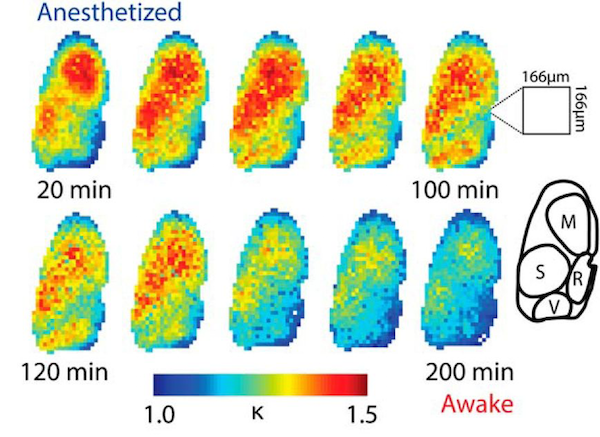
Criticality predicts a power law relationship in the brain. It also predicts that cortical dynamics should be independent of scale. In my previous post Engineered Proteins Enable Watching High Resolution Electrical Activity Across the Brain we saw that a recently published study (“Voltage Imaging of Waking Mouse Cortex Reveals Emergence of Critical Neuronal Dynamics” published December 10, 2014 in The Journal of Neuroscience) measured a power law relationship in awake brains consistent with brain dynamics adhering to the physical laws of self organizing criticality.
Are cortical dynamics independent of scale? The team looked to see if the observed cascade size distributions maintain the same form independent of scale, location, and resolution in a resting awake, but not in an anesthetized, animal. They calculated k values within small subregions of about two-tenths of a percent of the total cortical region imaged. These values were highly variable across the anesthetized cortex but for each subregion they converged towards k = 1 as the animal transitioned into the awake and resting state (see Figure 1 above).
In addition, k values were calculated across cortical subregions at 3 levels of spatial averaging across the raw data images. A raw data image was comprised of 15,676 pixels (each pixel averaged the signal from 33 square micrometers of cortex). Fine level images contained 3971 pixels (spatial average across 4 pixels), medium contained 290 pixels (spatial average across 54 pixels), and course contained 21 pixels (spatial average across 747 pixels). In the anesthetized state k values changed with scale (resolution) but in the awake and resting animal k values remained close to 1 at every scale. The research team concluded that cortical dynamics are independent of scale in the awake and resting brain but are scale dependent in the anesthetized animal.
Does the idea of criticality and its potential action in the brain provide us with useful insight to help us understand how our brains work? Neuroscience continues to lack a general theory describing small circuit and large network signal processing in the brain. To this end, a mathematical law or set of laws that may capture important features of observed brain dynamics is an exciting contribution.
The idea of self organized critical states derives from statistical mechanics. The behavior of complex systems can be organized in different types or phases separated one from the other by a sharp boundary or phase transition. There is a lot of very interesting work describing the electrical activity of individual neurons in terms of phases and phase transitions (see for example Dynamical Systems and Silicon Based Hybrid Spiking Neurons). When the system transitions from one phase to another, it experiences dramatic changes in behavior. At certain (second-order) phase transitions, fluctuations occur at all length scales and the system exhibits scale invariance and power-law behavior. Self organized critical systems are defined by second-order phase transitions.
Current results suggest that cerebral cortices function as self organized critical systems while awake and at rest. Cortex under pentobarbital anesthesia functions in the supercritical (k > 1) range of phases according to these data. It’ll be interesting to see how well this organizing principle holds across the many organs of the brain.